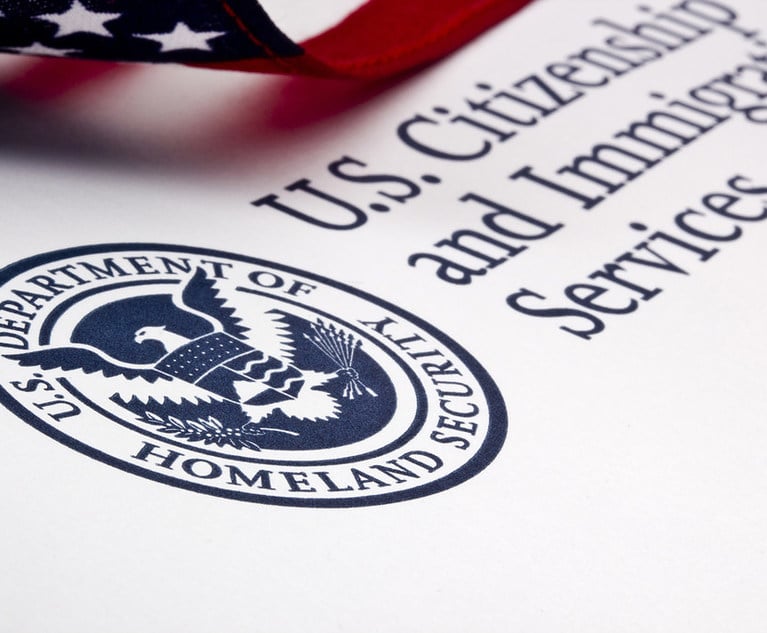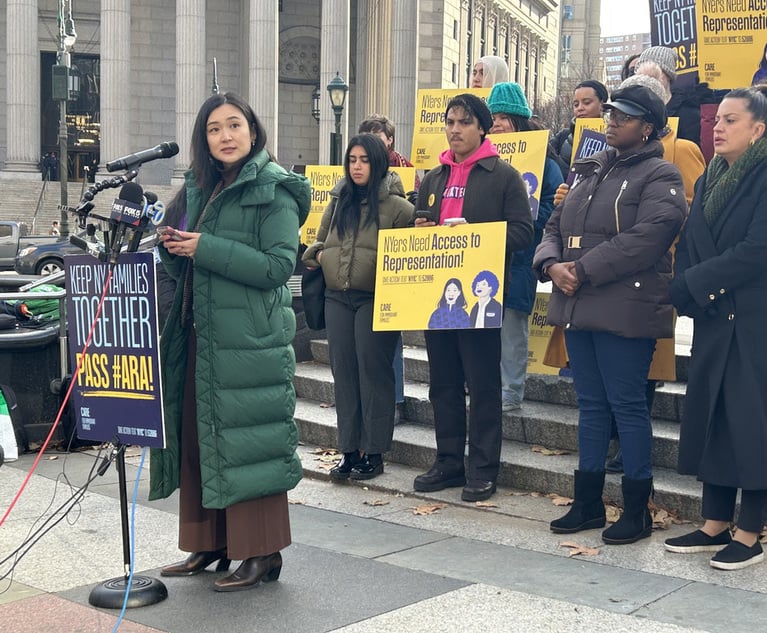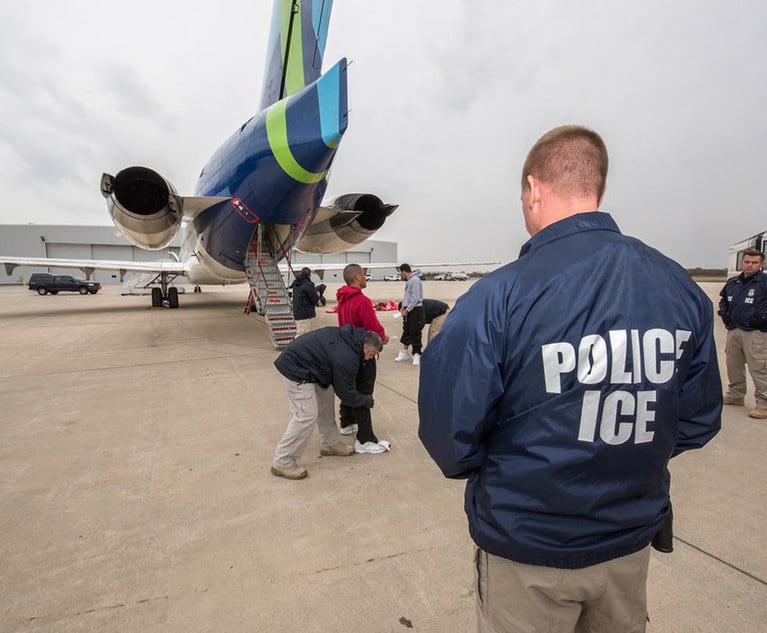 U.S. Citizenship and Immigration Services
U.S. Citizenship and Immigration ServicesImmigration Under the Trump Administration: Five Things to Expect in the First 90 Days
The authors write "The first Trump administration brought significant changes to U.S. immigration policies, which had profound impacts on businesses and individuals alike. Donald Trump has shared plans for closing the U.S. borders and enforcing mass deportations for undocumented immigrants almost immediately after taking office in January. Below are five major impacts to immigration policy we saw as a result of Trump's first term, and what we can expect for his second term."
December 11, 2024 at 04:52 PM
10 minute read
The first Trump administration brought significant changes to U.S. immigration policies, which had profound impacts on businesses and individuals alike. Donald Trump has shared plans for closing the U.S. borders and enforcing mass deportations for undocumented immigrants almost immediately after taking office in January. Below are five major impacts to immigration policy we saw as a result of Trump's first term, and what we can expect for his second term.
- Extreme Vetting: The administration introduced stringent vetting processes for visa applicants, with the stated aim of enhancing national security. This led to longer processing times and increased scrutiny of applicants' backgrounds. The U.S. Department of State, whose Bureau of Consular Affairs oversees the issuance of U.S. visas, has yet to recover from staffing shortages resulting from the first Trump administration, while geopolitical conflicts continue to grow in size and severity, drawing limited resources away from visa processing. Like under the first Trump administration, visa applicants – and the U.S. companies that employ them – can expect extremely long wait times for visa interview appointments, more frequent administrative processing delays, and much higher visa refusal rates. Foreign workers may be less able to travel internationally for work due to the risk of being unable to return to the U.S.
- Hiring and Onboarding Delays: Slow adjudication and consular operations, coupled with heavy scrutiny, caused significant delays in hiring and onboarding international employees. Businesses faced challenges in maintaining their high-skilled workforces due to these prolonged processes since such (legal) foreign workers are the cohort most affected by delays and increased scrutiny of work visa applications. Only the H-2 visa category for seasonal and temporary workers seems to have been unaffected by these delays. In fact, the number of available H-2 visas doubled under Trump, and applications maintained an average approval rate of over 98 percent. Given this history, employers should plan for delays in onboarding high-skilled foreign workers as well as decreased ability to recruit such candidates to the U.S., though the ability to recruit short-term and seasonal labor should remain steady.
- Business Disruption: Border closures, visa bans, skyrocketing processing times, and denial rates under the first Trump administration exacerbated the staffing issues faced by companies during the pandemic and recovery. Year-plus processing times caused foreign nationals working legally in the U.S. to lose their work authorization and, in some cases, their jobs as employers struggled to navigate the changing adjudication standards. Employers in highly scrutinized industries like construction, manufacturing, food service, hospitality, and agriculture can expect increased immigration enforcement activity, including raids. Raids, in particular, have a chilling impact on recruitment and hiring even of authorized workers, including workers permanently authorized to work in the U.S. – like U.S. citizens, permanent residents, and asylees. In 2022, a federal court ordered ICE to pay more than $1 million to victims of the agency's raid of a meatpacking plant in Tennessee, after determining ICE agents used racial profiling and excessive force to illegally detain workers without regard to their actual status – lawful or unlawful – in the U.S.
- Increased Costs: The cost of sponsoring employees for visas and green cards increased due to additional documentary requirements and higher denial rates. Businesses had to allocate more resources to manage immigration-related expenses. Under the incoming administration, employers can expect a return to those high immigration costs and then some. Since Biden took office, denial rates for H-1B visa applications have hovered between 2 – 3 percent; under Trump, H-1B denial rates were more than triple that, ranging from 8 – 15 percent.
- Uncertainty: In the first Trump administration, sudden policy changes, reduced service levels, and uncertain decisions created concern among employees and businesses. Companies had to adjust their expectations and factor in events that created disruptions impacting all levels of their business, including employee onboarding, production, and service delivery. We expect the impacts of the areas outlined above will lead to a significant number of additional uncertainties for both employers and employees that could impact workforce morale and productivity in anticipation of what could come.
- Policy Changes and Executive Orders: The previous Trump administration used executive orders, proclamations, and internal policy changes to implement these policies swiftly, causing confusion and making strategic planning difficult. The policy announcements and political nominations already proposed by the incoming administration indicate that the administration will seek to implement their restrictive immigration policy priorities as swiftly as possible after the transition in January 2025.
- Travel Bans: Travel bans implemented under the previous Trump administration prevented foreign nationals abroad from entering the U.S. It also deterred foreign nationals legally present in the U.S. from departing, due to the fear of being unable to return. Companies had to plan to ensure employees were not stranded outside the U.S. while expending substantial resources bringing stranded workers back to the U.S. or arranging for legal employment in other countries to mitigate losses.
- Increased Scrutiny: Immigration filings faced high scrutiny, with no deference given to previous approvals. Documentary requirements increased and denial rates rose significantly – exceeding 30 percent for some work visa categories.
Employers should expect the administration to take a restrictive approach to immigration. With Republican majorities in Congress, there is also a strong possibility that conservative immigration legislation will be passed. This means the policies and practices that affect employers the most could wind up enshrined in law, limiting the ability of future administrations to eliminate or reverse them. Even so, there are steps companies can take to mitigate the impact of these shifts in U.S. immigration policy.
NOT FOR REPRINT
© 2025 ALM Global, LLC, All Rights Reserved. Request academic re-use from www.copyright.com. All other uses, submit a request to [email protected]. For more information visit Asset & Logo Licensing.
You Might Like
View All
As Second Trump Administration Approaches, Businesses Brace for Sweeping Changes to Immigration Policy


Appellate Court Suspends NY Immigration Lawyer Now Practicing in Texas
Trending Stories
- 1'A Death Sentence for TikTok'?: Litigators and Experts Weigh Impact of Potential Ban on Creators and Data Privacy
- 2Bribery Case Against Former Lt. Gov. Brian Benjamin Is Dropped
- 3‘Extremely Disturbing’: AI Firms Face Class Action by ‘Taskers’ Exposed to Traumatic Content
- 4State Appeals Court Revives BraunHagey Lawsuit Alleging $4.2M Unlawful Wire to China
- 5Invoking Trump, AG Bonta Reminds Lawyers of Duties to Noncitizens in Plea Dealing
Who Got The Work
J. Brugh Lower of Gibbons has entered an appearance for industrial equipment supplier Devco Corporation in a pending trademark infringement lawsuit. The suit, accusing the defendant of selling knock-off Graco products, was filed Dec. 18 in New Jersey District Court by Rivkin Radler on behalf of Graco Inc. and Graco Minnesota. The case, assigned to U.S. District Judge Zahid N. Quraishi, is 3:24-cv-11294, Graco Inc. et al v. Devco Corporation.
Who Got The Work
Rebecca Maller-Stein and Kent A. Yalowitz of Arnold & Porter Kaye Scholer have entered their appearances for Hanaco Venture Capital and its executives, Lior Prosor and David Frankel, in a pending securities lawsuit. The action, filed on Dec. 24 in New York Southern District Court by Zell, Aron & Co. on behalf of Goldeneye Advisors, accuses the defendants of negligently and fraudulently managing the plaintiff's $1 million investment. The case, assigned to U.S. District Judge Vernon S. Broderick, is 1:24-cv-09918, Goldeneye Advisors, LLC v. Hanaco Venture Capital, Ltd. et al.
Who Got The Work
Attorneys from A&O Shearman has stepped in as defense counsel for Toronto-Dominion Bank and other defendants in a pending securities class action. The suit, filed Dec. 11 in New York Southern District Court by Bleichmar Fonti & Auld, accuses the defendants of concealing the bank's 'pervasive' deficiencies in regards to its compliance with the Bank Secrecy Act and the quality of its anti-money laundering controls. The case, assigned to U.S. District Judge Arun Subramanian, is 1:24-cv-09445, Gonzalez v. The Toronto-Dominion Bank et al.
Who Got The Work
Crown Castle International, a Pennsylvania company providing shared communications infrastructure, has turned to Luke D. Wolf of Gordon Rees Scully Mansukhani to fend off a pending breach-of-contract lawsuit. The court action, filed Nov. 25 in Michigan Eastern District Court by Hooper Hathaway PC on behalf of The Town Residences LLC, accuses Crown Castle of failing to transfer approximately $30,000 in utility payments from T-Mobile in breach of a roof-top lease and assignment agreement. The case, assigned to U.S. District Judge Susan K. Declercq, is 2:24-cv-13131, The Town Residences LLC v. T-Mobile US, Inc. et al.
Who Got The Work
Wilfred P. Coronato and Daniel M. Schwartz of McCarter & English have stepped in as defense counsel to Electrolux Home Products Inc. in a pending product liability lawsuit. The court action, filed Nov. 26 in New York Eastern District Court by Poulos Lopiccolo PC and Nagel Rice LLP on behalf of David Stern, alleges that the defendant's refrigerators’ drawers and shelving repeatedly break and fall apart within months after purchase. The case, assigned to U.S. District Judge Joan M. Azrack, is 2:24-cv-08204, Stern v. Electrolux Home Products, Inc.
Featured Firms
Law Offices of Gary Martin Hays & Associates, P.C.
(470) 294-1674
Law Offices of Mark E. Salomone
(857) 444-6468
Smith & Hassler
(713) 739-1250







